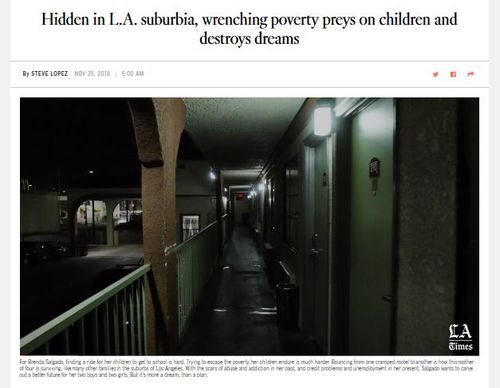It’s considered in poor taste to notice the connection between the flow of people over the border and 21st Century California’s relatively low standard of living, but from the Los Angeles Times today, a story about the poverty in the middle of the suburban San Fernando Valley:
Hidden in L.A. suburbia, wrenching poverty preys on children and destroys dreams
By STEVE LOPEZ
NOV 25, 2018 | 5:00 AM
… School had been in session less than two months when Brenda Salgado and her kids packed and moved. It was mid-September and they’d already been in three places. First a motel, then a two-bedroom apartment stuffed with more than two dozen people, then one of the many discount lodges on a dreary stretch of Sepulveda Boulevard in North Hills.
… The $95 room had two beds, a dark rug, harsh light and the familiar, unnatural scent of motel sanitizing agents. There was no kitchen, no quiet corner for homework, no outdoor space. Anthony, 9, Jordan, 6, and Madelyn, 5, were dressed and ready for school at Telfair Elementary, six miles away in Pacoima. One-year-old Mayla, dark-haired and curious, sat upright on a bed and looked me over.
The most disturbing thing about the scene was that for the kids, this was no temporary setback. This was life, dragging belongings from one place to the next, tethered to problems they didn’t create. …
Los Angeles Unified, the second-largest public school system in the country, is more than a sprawling collection of campuses — it’s one of the nation’s largest depositories of child poverty. About 80% of the more than 600,000 students qualify for free or reduced-price meals. When I heard from Supt. Austin Beutner that nearly a quarter of the students at Telfair last year were classified as homeless, I began visiting the school and the neighborhood, hoping to give some human shape to the numbers.
You don’t see sprawling tent villages on the streets around Telfair, and there’s little of the squalor so starkly evident on skid row and elsewhere. Poverty is quieter here. It lives indoors for the most part. To an extent, it’s hidden in the fabric of the suburban design, and for all the focus on homeless encampments in Los Angeles, far more people cope with cramped, inadequate, barely affordable housing.
Like I said, appearances can be deceiving. Rows of small stucco houses line the streets near Telfair, where the median household income hits the county average of about $54,000, and you can still buy a home for less than $500,000.
But the neighborhood has changed dramatically over the decades, said fifth-grade teacher Sandra Tejeda, a former Telfair student who has taught there for 29 years. Tejeda still lives down the street from the school in the house she grew up in.
“Oh my goodness, things were beautiful,” Tejeda told me as we sat in her classroom after school one day. “People had front lawns, everybody owned their house, we knew who was in each house and we knew we were safe.”
“It used to be single families… Now you see multiple families in a home, in a garage, in makeshift shanties.”
Now, Tejeda said, you see vehicles parked in some yards where gardens once thrived, and small villages of people live on some properties.
“It used to be single families,” said first-grade teacher Gricelda Gutierrez, another former Telfair student who stopped by Tejeda’s class to join our conversation. “Now you see multiple families in a home, in a garage, in makeshift shanties.”
So what drove the change?
More poverty. More renters. Fewer good jobs.
Tejeda’s father worked at the General Motors plant in Van Nuys. In August 1992, the last car — a red Chevy Camaro — rolled off the assembly line where 6 million cars had been produced in 45 years.
My Uncle Chuck worked at that GM plant in the 1960s. He owned a house with a pool in Granada Hills and a weekend cabin in a forest up at Big Bear Lake.
Now the GM plant’s location is a multiplex movie theater called The Plant, a development put together by the Selleck family. The Sellecks (actor Tom and his developer dad and brothers) talked the LAPD into building a training facility across the parking lot from their movie theater, so it’s safe and prosperous.
The Plant movie theater is seven miles north of the intersection of Beverly Glen and Mulholland Drive at the crest of the Hollywood Hills above Beverly Hills.
The following year, The Times ran a story about the death of blue- and white-collar jobs in San Fernando Valley’s once soaring aerospace industry. Hughes Aircraft, Litton Industries, Northrop, Rocketdyne and Lockheed Martin were scaling back or closing altogether. In good times, Pacoima residents didn’t have to work at those places to benefit from the money those jobs sent rippling through the local economy.
The end of the Cold War hit L.A. hard. Much of SoCal’s historic high standard of living for factory workers and engineers had been subsidized by taxpayers in other states.
Just up the street from Telfair, hundreds of union jobs were lost in 1997 when Price Pfister, a kitchen faucet manufacturer, moved production to Mexico. …
Today, a Lowe’s home improvement center stands on the spot where Price Pfister made its faucets.
Lowe’s sells Pfister faucets.
Made in Mexico. …
“I’ve got this friend who bought a four-bedroom house near here,” Pozo said. “He rents each bedroom for $750, and it’s $900 for the bedroom with a bathroom. For the garage, he gets $1,500.”
So that’s $4,650 in rent per month, assuming you can have 100% occupancy.
Supply and demand.
[Comment at Unz.com]













